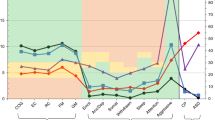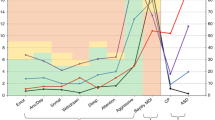Abstract
Background
To analyze the relationship of child behavioral and communication disorders, and adverse family events, to later-in-life child health and cognitive function among youth born extremely preterm.
Methods
The study participants were 694 children enrolled in the Extremely Low Gestational Age Newborn Study. At ages 2 and 10, we assessed internalizing and externalizing behaviors, and at age 10, we assessed adverse life events within the family. Associations were evaluated between these child and family factors and positive child health at age 10 years, and global health and cognitive function at age 15 years.
Results
Lower T-scores for internalizing or externalizing behaviors at age 2 were associated with more positive health at age 10. The absence of internalizing behaviors at age 10 was associated with better global child health and better cognitive function at age 15. The absence of communication deficits at age 10 was associated with better cognitive function at age 15. The absence of parent job loss was associated with better global child health at age 15.
Conclusion
Among individuals born extremely preterm, child health and cognitive outcomes might be improved by timely interventions to address child behavioral symptoms and the impact of adverse life events in the family.
Impact
-
The absence of child behavioral and communication disorders, and adverse family events, were associated with more positive health, higher global health, and better cognitive function among youth born extremely preterm.
-
Interventions to address behavioral disorders in early childhood, and to reduce the impact of adverse life events on the family, might promote improved health and developmental outcomes for adolescents born extremely preterm.
This is a preview of subscription content, access via your institution
Access options
Subscribe to this journal
Receive 14 print issues and online access
$259.00 per year
only $18.50 per issue
Buy this article
- Purchase on Springer Link
- Instant access to full article PDF
Prices may be subject to local taxes which are calculated during checkout
Similar content being viewed by others
Data availability
ELGAN Study data through 10 years of follow-up are available from Archived Clinical Research Datasets by completing the NINDS Data Request Form. ELGAN Study after age 10 is expected to be available in 2022 from the NIH-sponsored Environmental Influences on Child Health Outcomes (ECHO) study. Those interested in data from the ECHO Study are encouraged to contact the coordinating center for that study: https://www.nih.gov/research-training/environmental-influences-child-health-outcomes-echo-program.
References
Taylor, G. L. & O’Shea, T. M. Extreme prematurity: risk and resiliency. Curr. Probl. Pediatr. Adolesc. Health Care 52, 101132 (2022).
Patel, R. M. Short- and long-term outcomes for extremely preterm infants. Am. J. Perinatol. 33, 318–328 (2016).
Stensvold, H. J. et al. Neonatal morbidity and 1-year survival of extremely preterm infants. Pediatrics 139, e20161821 (2017).
Marlow, N., Wolke, D., Bracewell, M. A., Samara, M. EPICure Study Group Neurologic and developmental disability at six years of age after extremely preterm birth. N. Engl. J. Med. 352, 9–19 (2005).
Joseph, R. M. et al. Neurocognitive and academic outcomes at age 10 years of extremely preterm newborns. Pediatrics 137, e20154343 (2016).
Bangma, J. T. et al. Assessing positive child health among individuals born extremely preterm. J. Pediatr. 202, 44–49.e44 (2018).
Campbell, H. et al. Neonatal cranial ultrasound findings among infants born extremely preterm: associations with neurodevelopmental outcomes at 10 years of age. J. Pediatr. 237, 197–205.e194 (2021).
Sriram, S. et al. Cognitive development and quality of life associated with bpd in 10-year-olds born preterm. Pediatrics 141, e20172719 (2018).
Bangma, J. T., Hartwell, H., Santos, H. P. Jr., O’Shea, T. M. & Fry, R. C. Placental programming, perinatal inflammation, and neurodevelopment impairment among those born extremely preterm. Pediatr. Res. 89, 326–335 (2021).
Dvir, Y. et al. Psychiatric symptoms: prevalence, co-occurrence, and functioning among Extremely Low Gestational Age Newborns at age 10 years. J. Dev. Behav. Pediatr. 40, 725–734 (2019).
Johnson, S. et al. Psychiatric disorders in extremely preterm children: longitudinal finding at age 11 years in the Epicure Study. J. Am. Acad. Child Adolesc. Psychiatry 49, 453–463.e451 (2010).
Johnson, S. & Marlow, N. Early and long-term outcome of infants born extremely preterm. Arch. Dis. Child. 102, 97 (2017).
Blok, E. et al. Cognitive performance in children and adolescents with psychopathology traits: a cross-sectional multicohort study in the general population. Dev. Psychopathol. 1–15 (2022).
Botting, N., Durkin, K., Toseeb, U., Pickles, A. & Conti-Ramsden, G. Emotional health, support, and self-efficacy in young adults with a history of language impairment. Br. J. Dev. Psychol. 34, 538–554 (2016).
Dubois, P., St-Pierre, M.-C., Desmarais, C. & Guay, F. Young adults with developmental language disorder: a systematic review of education, employment, and independent living outcomes. J. Speech Lang. Hearing Res. 63, 3786–3800 (2020).
Soni, R., Tscherning Wel-Wel, C. & Robertson, N. J. Neuroscience meets nurture: challenges of prematurity and the critical role of family-centred and developmental care as a key part of the neuroprotection care bundle. Arch. Dis. Child Fetal Neonatal Ed. 107, 242–249 (2022).
McDonald, S. W., Kehler, H. L. & Tough, S. C. Protective factors for child development at age 2 in the presence of poor maternal mental health: results from the All Our Babies (AoB) Pregnancy Cohort. BMJ Open 6, e012096 (2016).
Golberstein, E., Gonzales, G. & Meara, E. How do economic downturns affect the mental health of children? Evidence from the National Health Interview Survey. Health Econ. 28, 955–970 (2019).
Pierce, M. et al. Effects of parental mental illness on children’s physical health: systematic review and meta-analysis. Br. J. Psychiatry 217, 354–363 (2020).
Lindström, M. & Rosvall, M. Parental separation in childhood and self-reported psychological health: a population-based study. Psychiatry Res. 246, 783–788 (2016).
Morgan, A. S., Mendonça, M., Thiele, N. & David, A. L. Management and outcomes of extreme preterm birth. BMJ 376, e055924 (2022).
Li, Y. et al. Pesticide metabolite concentrations in queensland pre-schoolers – exposure trends related to age and sex using urinary biomarkers. Environ. Res. 176, 108532 (2019).
O’Shea, T. M. et al. The ELGAN Study of the brain and related disorders in Extremely Low Gestational Age Newborns. Early Hum. Dev. 85, 719–725 (2009).
Achenbach, T. M. & Ruffle, T. M. The Child Behavior Checklist and related forms for assessing behavioral/emotional problems and competencies. Pediatr. Rev. 21, 265–271 (2000).
Sprafkin, J. Further evidence of reliability and validity of the Child Symptom Inventory-4: parent checklist in clinically referred boys. J. Clin. Child Adolesc. Psychol. 31, 513–524 (2002).
Norbury, C. F., Nash, M., Baird, G. & Bishop, D. Using a parental checklist to identify diagnostic groups in children with communication impairment: a validation of the Children’s Communication Checklist–2. Int J. Lang. Commun. Disord. 39, 345–364 (2004).
Bishop, D. V. M., Maybery, M., Wong, D., Maley, A. & Hallmayer, J. Characteristics of the broader phenotype in autism: A study of siblings using the children’s communication checklist-2. Am. J. Med. Genet. 141B, 117–122 (2006).
Bangma, J. T. et al. Early life antecedents of positive child health among 10-year-old children born extremely preterm. Pediatr. Res. 86, 758–765 (2019).
Broderick, J. E., DeWitt, E. M., Rothrock, N., Crane, P. K. & Forrest, C. B. Advances in patient-reported outcomes: The NIH Promis(®) Measures. EGEMS (Wash DC) 1, 1015 (2013).
Forrest, C. B., Blackwell, C. K. & Camargo, C. A. Jr. Advancing the science of children’s positive health in the National Institutes of Health Environmental Influences on Child Health Outcomes (Echo) Research Program. J. Pediatr. 196, 298–300 (2018).
Forrest, C. B. et al. Concurrent validity of the Promis® Pediatric Global Health Measure. Qual. Life Res. 25, 739–751 (2016).
Forrest, C. B. et al. Development of the Promis® Pediatric Global Health (PGH-7) Measure. Qual. Life Res. 23, 1221–1231 (2014).
Wechsler, D. Wechsler Abbreviated Scale of Intelligence Second Edition (WASI-II) (The Psychological Corporation, San Antonio, TX, 2011).
Akshoomoff, N. et al. VIII. NIH Toolbox Cognition Battery (CB): composite scores of crystallized, fluid, and overall cognition. Monogr. Soc. Res. Child Dev. 78, 119–132 (2013).
Heeren, T. et al. Cognitive functioning at the age of 10 years among children born extremely preterm: a latent profile approach. Pediatr. Res. 82, 614–619 (2017).
Knief, U. & Forstmeier, W. Violating the normality assumption may be the lesser of two evils. Behav. Res. Methods 53, 2576–2590 (2021).
Fall, C. H. D. et al. Association between maternal age at childbirth and child and adult outcomes in the offspring: a prospective study in five low-income and middle-income countries (cohorts collaboration). Lancet Glob. Health 3, e366–e377 (2015).
Beck, A. F. et al. The color of health: how racism, segregation, and inequality affect the health and well-being of preterm infants and their families. Pediatr. Res. 87, 227–234 (2020).
Joseph, R. M., O’Shea, T. M., Allred, E. N., Heeren, T. & Kuban, K. K. Maternal educational status at birth, maternal educational advancement, and neurocognitive outcomes at age 10 years among children born extremely preterm. Pediatr. Res. 83, 767–777 (2018).
Poehlmann-Tynan, J. et al. Risk and resilience in preterm children at age 6. Dev. Psychopathol. 27, 843–858 (2015).
Papachristou, E. & Flouri, E. The codevelopment of internalizing symptoms, externalizing symptoms, and cognitive ability across childhood and adolescence. Dev. Psychopathol. 32, 1375–1389 (2020).
Flouri, E. et al. Developmental cascades of internalising symptoms, externalising problems and cognitive ability from early childhood to middle adolescence. Eur. Psychiatry 57, 61–69 (2019).
Ni, Y., O’Reilly, H., Johnson, S., Marlow, N. & Wolke, D. Health-related quality of life from adolescence to adulthood following extremely preterm birth. J. Pediatr. 237, 227–236.e225 (2021).
Barfield, P. A. Life satisfaction in children with attention deficit hyperactivity disorder: looking beyond proxy reports. J. Child Adolesc. Psychiatr. Nurs. 31, 102–108 (2018).
Adams, S. Y., Davis, T. W. & Lechner, B. E. Perspectives on race and medicine in the NICU. Pediatrics 147, e2020029025 (2021).
Acknowledgements
The authors would like to acknowledge the contributions of the ELGAN subjects and the ELGAN subjects’ families.
Funding
Some of the first author’s time was supported by a Hillman Scholars Nursing Innovation Scholarship, the Arthur C. Maimon Doctoral Student Research Award and Linda Waring Matthews Research Fund. This study was also supported by grants from the National Institute of Neurological Disorders and Stroke (U01NS040069 to Alan Leviton; (R01NS040069 to K.K.C.K.), the National Institute of Child Health and Human Development (R01HD092374 to T.M.O. and R.C.F., R03HD101413 to H.P.S.), the National Institute of Nursing Research (R01NR019245 to H.P.S.), and the Office of the NIH Director (UG3OD023348 to T.M.O.), The content is solely the responsibility of the authors and does not necessarily represent the official views of any of the funders.
Author information
Authors and Affiliations
Contributions
All authors have agreed on the final version and meet at least one of the following criteria [recommended by the ICMJE (http://www.icmje.org/ethical_1author.html)]: substantial contributions to conception and design, acquisition of data, or analysis and interpretation of data; and drafting the article or revising it critically for important intellectual content.
Corresponding author
Ethics declarations
Competing interests
The authors declare no competing interests.
Additional information
Publisher’s note Springer Nature remains neutral with regard to jurisdictional claims in published maps and institutional affiliations.
Rights and permissions
Springer Nature or its licensor (e.g. a society or other partner) holds exclusive rights to this article under a publishing agreement with the author(s) or other rightsholder(s); author self-archiving of the accepted manuscript version of this article is solely governed by the terms of such publishing agreement and applicable law.
About this article
Cite this article
Emmanuel, C., Yi, J.X., Joseph, R.M. et al. Child and family factors associated with positive outcomes among youth born extremely preterm. Pediatr Res 94, 172–177 (2023). https://doi.org/10.1038/s41390-022-02424-x
Received:
Revised:
Accepted:
Published:
Issue Date:
DOI: https://doi.org/10.1038/s41390-022-02424-x



